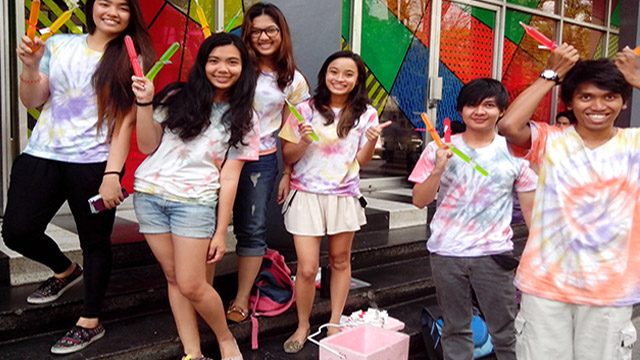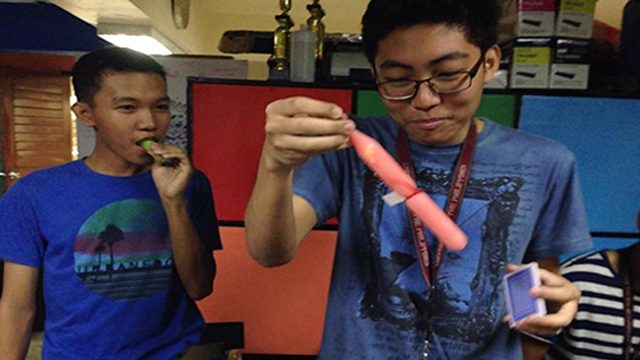SUMMARY
This is AI generated summarization, which may have errors. For context, always refer to the full article.

I spent the last semester taking an Art Studies class, oblivious and ill-equipped to receive in both hands the gravitational impact it would make on how I viewed art.
As a final requirement, my groupmates and I were assigned a social artistry project that required using art with live people. Not necessarily live art per se, but art that would live.
Art: In principle, theoretically speaking
We designed our project around the popular and all too familiar social paradox that has plagued many people of this age, especially the youth: everyone is attached to screens, day in and day out. We wanted to encourage peace and mindfulness by directly interrupting people who are idly swiping, scrolling or typing.
Ice candy has been a long-time treat enjoyed by Filipinos at least once in childhood. So we used ice candy to bring our target audience back to “reality,” encouraging the recall of simple pleasures and sharing it with a stranger or a friend next to them. Each ice candy we handed to a pair or group of people had a tag that said one of the following: Dance with someone, hug someone, ‘high 5’ someone, smile at someone, or share a joke with someone. In order to receive it, they had to accomplish the task written on their respective ice candy.
We went around UP Diliman campus, with a box of ice candies in hand, and approached college and grade school students, workers, and everybody else we met along the way.

Our social artistry project, entitled “Peace Pops,” focused on encouraging others to disconnect from the virtual world by engaging, for a few minutes, with the people around them. This project helped me realize that art does not always have to produce good critiques – a difficult task to ask of one majoring in science like myself.
Beyond the publication and dissemination of art and its criticism, art in itself is a vehicle that moves, and moves the people that receive it. Art is not an aesthetic science, to be stripped and scrutinized. Art is a well of life, used to revive and receive the things that rejuvenate us from the chaos of our everyday world. It desires us to experience. A tangible example of this is social artistry.
Social artistry is not simply to be directly looked upon as in a painting – it is received; felt. It surprises, inspires, questions.
To say that art should be rightfully quarantined from such things is impossible. We cannot relate with art that does not touch the deepest parts of our soul; the parts that are troubled from external chaos.
Art: In people, socially speaking
Crowds of aspiring engineers, scientists, artists, and writers are often vacantly staring at their phones as they navigate from corner to corner of campus.
During the implementation of our project, we had grade school children taking recess breaks from the UP Integrated School (UPIS) chasing after us just to have an ice candy, even at the expense of ‘high 5s’ and dances.
Fresh acquaintances in social circles shared a hug, possibly a new leap into their friendship. Two friends danced to a Frozen song, “Love Is An Open Door,” to share an ice candy on a hot afternoon.

It is these interruptions, these silly and awkward requests, that temporarily stop the swiping, clicking and typing, and engages people. It engages touch, laughter, and kindness. It is tingling and surprising how the vibrations of social laughter and frivolity contrast with the mundane silence of social media.
The joy of watching people connect through our project is something I could not extract from simply staring at a painting or sculpture, but it is a joy I can now apply in doing the latter. For I would know then that the artist’s intention is to engage me with his ideas and emotions through his craft. It is personal and touching.The artist and I are having a conversation, and he is moving me to agree with his own passions, through the use of his hands and his eyes, not his words.
Social artistry is the first art I encountered that taught me how to appreciate the purpose of art – not just looking at art itself – because I encountered first-hand what it can do to people. It is quite difficult to purge yourself of any predilections about art appreciation being pretentious and airy, because that’s what’s shown in movies and popular culture.
I’ve found that the best way to appreciate art, even art simply hung on walls, isn’t just to isolate each of its components and study them meticulously. Social artistry shows us how art is also meant to serve, re-awaken or inspire us back to our more essential, but often forgotten values – like peace, mindfulness and the spirit of sharing – against the burgeoning culture of raging speed and individual isolation in this age of gadgets. – Rappler.com
Liza Valencia is an undergraduate student at the University of the Philippines Diliman pursuing a degree in Food Technology. Outside of analyzing food to its miniscule constituents in the lab, she is a long distance runner, a devoted science-fiction/fantasy fan, and book hoarder. She hopes to someday help make food richer, and more accessible and abundant to the hungry.
Add a comment
How does this make you feel?
There are no comments yet. Add your comment to start the conversation.